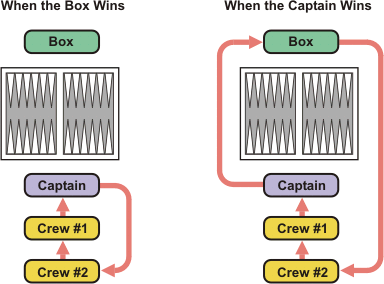![[Backgammon Galore!]](/gif/GaloreButton.gif)
|
|
Backgammon Variants The following description contains the basic rules for chouettes. There are many variations to these rules, and newcomers to a club should take some time to learn the local customs before they play. Order of play: To start, each player throws one die and in the event of a tie there is a reroll. The player rolling highest becomes the box and plays against all the others who form a team. The second highest becomes the captain of the team. The captain rolls the dice and makes the plays for the team. When the box wins a game, he collects from each member of the team. Then the captain goes to the back of the line and the next player on the team becomes the captain. When the team wins, the box pays off to each team member. Then he goes to the back of the line and the captain becomes the new box.
Players can leave or join a chouette at any time. A new player starts at the bottom of the rotation. Consultation: Customs vary as to the rights of the team: In some chouettes, they may consult freely as to how rolls should be played. In others, consultation is prohibited. A popular compromise permits consultation only after the cube has been turned. Single cube games: A chouette may be played with either a single doubling cube or multiple cubes. In a single-cube game, the only decision that the members of the team make individually concerns takes. If the box doubles, each team member can decide on his own whether to play on or drop out. Those who drop out each pay off to the box and no longer participate as team advisers. If the captain drops out while there are others on the team who wish to play on, the captaincy is assumed by one of these players and the previous captain drops to the bottom of the rotation. When only one player takes: It is common in chouettes of five or more to have a rule which says: if all the other team members want to reject the box's initial double, then a single holdout must drop as well. This prevents the situation of a majority of the players not having an interest in the remainder of the game. Mandatory extras: Another popular rule is that when a single player accepts the box's initial double he is obliged to accept an extra 2-cube from any team member that wishes to pay him one point. The receiver of an "extra" now owns multiple cubes which he may use individually to redouble, and which he will eventually pay on or collect from in the usual way. Multiple cube games: Most chouettes today use multiple cubes. Each member of the team has his own doubling cube. The box can double the individual team members, and each team member can decide whether and when to double the box. With multiple cubes in play, it is possible for the box to win against some players while losing against others. So the question arises, when does a player get to keep the box? The usual rule is that a player retains the box if he defeats the captain. Partner for the box: Chouettes of eight or more players often permit the box to take a partner. The partnership is offered in rotation, starting with the captain and moving on down the line. If no one offers to be the box's partner, a partner may be chosen by lot from among the team members other than the captain.
Sample RulesThere is no universal set of rules for Chouette; different clubs treat different situations differently. Here are some examples of specific rules for running a Chouette.1931 Chouette Rules: These rules were prepared in 1931 by the Racquet and Tennis Club of New York City in consultation with other American backgammon clubs. This was only a few years after Chouettes were first played. In those days, all Chouettes were single-cube games. ABA Chouette Rules: These rules were prepared by the Atlanta Backgammon Association. They are much more elaborate than the original Chouette rules, dealing with things such as different players playing for different stakes, and rules for consultation, settlements, and mandatory extras.
More Information
|
![]()
Backgammon Galore : Variants

